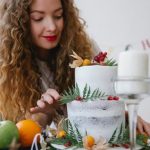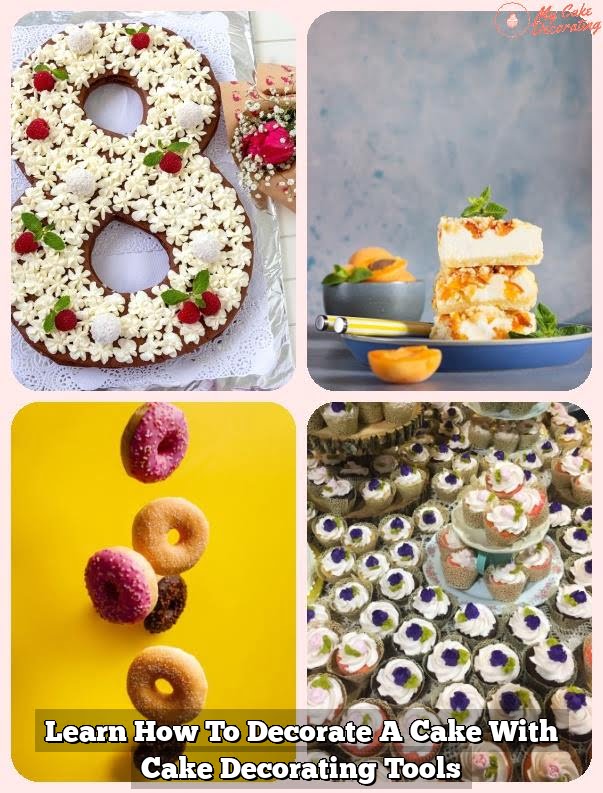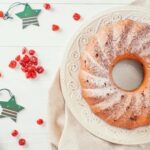Are you looking to add a special touch to your vanilla cake? Whether it’s for a birthday, anniversary, or just because, learning how to decorate a vanilla cake can be a fun and rewarding experience. In this article, we’ll explore the essential tools and ingredients needed for decorating a vanilla cake, as well as provide you with step-by-step guidance on baking the perfect vanilla cake from scratch.
In the world of baking, few things are more delightful than a tender and moist vanilla cake. And when it comes to decorating, the possibilities are endless.
From choosing the right frosting and filling to incorporating decorative techniques and fresh fruit, there are countless ways to elevate your vanilla cake into an edible work of art. Whether you’re a novice baker or an experienced pastry chef, this article will provide you with all the inspiration and guidance you need to create a picture-perfect vanilla cake that will impress your friends and family.
So if you’re ready to take your baking skills to the next level and create stunning desserts that look just as good as they taste, read on for expert tips and creative ideas on how to decorate a vanilla cake that will leave everyone wanting more. Let’s dive in.
Essential Tools and Ingredients for Decorating a Vanilla Cake
Decorating a vanilla cake requires the use of essential tools and ingredients to ensure that the finished product looks and tastes as good as it possibly can. Some essential tools for decorating a vanilla cake include an offset spatula for spreading frosting, a turntable for smooth and even application, piping bags and tips for creating intricate designs, and a bench scraper for achieving clean edges.
In terms of ingredients, high-quality vanilla extract or vanilla bean paste is essential for achieving the classic flavor of a vanilla cake. Other key ingredients include all-purpose flour, sugar, baking powder, salt, unsalted butter, eggs, milk, and sour cream.
In addition to these basic tools and ingredients, there are some optional items that can take your vanilla cake decorating to the next level. These include food coloring gels or powders for customizing frosting colors, edible glitter or luster dust for adding sparkle and shine, and various decorative elements such as sprinkles, chocolate shavings, or edible flowers. Of course, the specific tools and ingredients needed will vary depending on the design you have in mind for your vanilla cake.
When it comes to selecting tools and ingredients for decorating a vanilla cake, it’s important to invest in quality items that will help you achieve professional-looking results. While some basic tools will suffice for beginners, serious bakers may want to expand their collection with specialized equipment designed for intricate decorations. As for ingredients, using high-quality products will not only enhance the taste of your vanilla cake but also contribute to its overall visual appeal.
| Essential Tools | Essential Ingredients |
|---|---|
| Offset spatula | All-purpose flour |
| Turntable | Sugar |
| Piping bags and tips | Vanilla extract/vanilla bean paste |
| Bench scraper | Unsalted butter |
Step-by-Step Guide on Baking the Perfect Vanilla Cake
The key to a delicious vanilla cake lies in the perfect balance of ingredients and meticulous baking process. To start, preheat your oven to the recommended temperature stated in your chosen vanilla cake recipe. While the oven is heating up, prepare your cake pans by greasing them with butter or cooking spray and dusting them with flour to prevent sticking.
Next, gather all the necessary dry ingredients – flour, sugar, baking powder, and salt – and sift them together in a large mixing bowl. In a separate bowl, combine the wet ingredients: eggs, milk, vegetable oil, and vanilla extract. Gradually add the dry mixture into the wet mixture, stirring until everything is well-combined.
Once your cake batter is ready, divide it evenly between the prepared cake pans. Use a spatula to smooth out the tops of the batter to ensure even baking. Place the pans in the preheated oven and bake for about 25-30 minutes or until a toothpick inserted into the center comes out clean.
After baking, remove the cakes from the oven and let them cool in their pans for about 10-15 minutes before transferring them onto a wire rack to cool completely. Once cooled, you can proceed with frosting and decorating your perfect vanilla cake as desired.
Tips for Achieving the Ideal Texture and Flavor for Your Vanilla Cake
When it comes to baking the perfect vanilla cake, achieving the ideal texture and flavor is crucial. Here are some tips to help you create a delectable vanilla cake that will have everyone coming back for more:
- Use high-quality ingredients: The key to a delicious vanilla cake starts with using high-quality ingredients. Opt for pure vanilla extract, good quality butter, and fresh eggs for the best flavor.
- Properly measure your ingredients: Baking is a science, so it’s important to measure your ingredients accurately. Invest in a kitchen scale to measure your flour, sugar, and other dry ingredients for precise results.
- Cream the butter and sugar properly: When creaming your butter and sugar, make sure to beat them together until light and fluffy. This step helps incorporate air into the batter, resulting in a lighter texture for your cake.
- Don’t overmix the batter: Overmixing can lead to a tough and dense cake. Mix your batter until all the ingredients are just combined to avoid ending up with a tough texture.
- Add sour cream or buttermilk: To enhance the flavor and moisture of your vanilla cake, consider adding sour cream or buttermilk to the batter. These ingredients will result in a tender and moist crumb that is sure to impress.
By following these tips, you’ll be well on your way to baking a vanilla cake with an ideal texture and flavor that will delight all who indulge in it.
Choosing the Right Frosting and Filling for Your Vanilla Cake
When it comes to decorating a vanilla cake, choosing the right frosting and filling is crucial in achieving the perfect flavor combination and aesthetic appeal. The type of frosting and filling you choose can make or break the overall taste and appearance of your cake, so it’s important to consider your options carefully.
Frosting Options
One of the most popular choices for frosting a vanilla cake is buttercream. Whether it’s traditional American buttercream, Swiss meringue buttercream, or Italian meringue buttercream, each type has its own unique texture and flavor profile. Another option is cream cheese frosting, which adds a tangy and slightly savory element to the sweetness of the vanilla cake. For those looking for a lighter alternative, whipped cream frosting can be a delicious choice that complements the delicate flavor of vanilla.
Filling Varieties
When it comes to filling your vanilla cake, there are endless possibilities. From fruit preserves to chocolate ganache, you can customize your filling based on your personal preferences and the theme of your cake. If you’re looking for something extra decadent, consider incorporating flavored curds or mousses for a burst of vibrant flavor within each bite.
Combining Flavors
To create a truly memorable vanilla cake, consider experimenting with different flavor combinations for both the frosting and filling. For example, pairing a classic vanilla buttercream with a tart lemon curd filling can create an irresistible sweet and tangy contrast that elevates the overall taste experience. Similarly, combining a rich chocolate ganache with a fluffy vanilla chiffon cake can offer a delightful blend of flavors that will impress anyone who takes a bite.
By carefully choosing the right frosting and filling for your vanilla cake, you can enhance its taste and visual appeal, making it an unforgettable centerpiece for any occasion. Consider experimenting with different combinations until you find the perfect pairing that suits your personal tastes and style preferences.
Creative Ideas for Decorating a Vanilla Cake With Buttercream Frosting
Buttercream frosting is a classic choice for decorating a vanilla cake, as its creamy texture and versatility make it perfect for a wide range of creative designs. One popular technique is to create a smooth, polished finish on the cake using a palette knife or offset spatula. This allows for a clean canvas on which to add further decorations such as piped borders, rosettes, or other intricate designs.
For those looking to add some color and flair to their vanilla cake, buttercream frosting can be easily tinted with food coloring. This opens up endless possibilities for themed cakes – from pastel shades for baby showers to vibrant hues for birthday celebrations. Stencils can also be used to imprint patterns onto the buttercream, adding an elegant touch to the cake’s appearance.
Another popular trend in vanilla cake decorating is the use of ombre buttercream. This involves blending different shades of frosting together in a gradient effect, creating a stunning visual effect that is sure to impress any guests. Whether going for a subtle transition from light to dark or making a bold statement with vibrant colors, ombre buttercream adds an extra dimension to the decoration of a vanilla cake.
Using Fondant and Decorative Techniques to Elevate Your Vanilla Cake
Fondant is a versatile sugar paste that can be rolled out and draped over a cake for a smooth, pristine finish. It can also be sculpted and molded into various shapes, making it an excellent choice for creating intricate designs and decorations.
To start, you will need to prepare a smooth frosted vanilla cake as the base for your fondant application. Once the cake is prepared, knead the fondant until it is pliable, then roll it out to the desired thickness on a clean, dry surface dusted with powdered sugar to prevent sticking.
After rolling out the fondant, carefully lift it using a rolling pin and drape it over the top of the cake. Smooth the fondant starting from the center and working outward to remove any wrinkles or air bubbles. Use a sharp knife to trim off any excess fondant around the base of the cake.
To add decorative elements, such as flowers, bows, or intricate patterns, use small cookie cutters or specialized fondant tools to cut out shapes or create textures directly on the fondant. You can also use food coloring to tint the fondant before shaping it into different designs for a more vibrant and personalized touch.
In addition to traditional fondant decorations, consider incorporating other decorative techniques like quilting, ruffles, or draping for added visual interest. Quilting involves creating patterns of intersecting lines in the fondant with a stitching tool or ruler embosser while ruffles require thinly rolled strips of fondant arranged in soft waves around the sides of the cake.
Draping involves elegantly folding and arranging sheets of fondant to create cascading fabric-like folds on your vanilla cake. Using these decorative techniques along with fondant can take your vanilla cake decorating skills to new heights and leave a lasting impression on your guests.
Incorporating Fresh Fruit and Edible Flowers for a Stunning Vanilla Cake Decoration
Fresh fruit and edible flowers can add a beautiful and natural touch to your vanilla cake, elevating its visual appeal and adding a pop of color. When incorporating these elements into your cake decoration, it’s important to consider the flavor combination, as well as the overall aesthetic.
When choosing fresh fruit for your vanilla cake decoration, consider options such as berries, sliced peaches, or citrus segments. These fruits not only bring vibrant colors to the cake but also offer a refreshing flavor that complements the sweetness of the vanilla. Edible flowers like roses, violets, lavender, or pansies can also be used to enhance the visual appeal of the cake. It’s essential to ensure that any flowers you use are indeed edible and free from pesticides.
To incorporate fresh fruit into your vanilla cake decoration, consider using them as a topping or filling between cake layers. You can arrange them in a decorative pattern on top of the frosting or use them to create a border around the edge of the cake. For edible flowers, they can be strategically placed on top of the frosting or cascading down the side for an elegant and whimsical look.
In addition to enhancing the visual appeal of your vanilla cake, fresh fruit and edible flowers also provide an opportunity to infuse additional flavors into your creation. The natural sweetness and juiciness of fruit paired with delicate floral notes from edible flowers can create a delightful sensory experience for anyone enjoying your beautifully decorated vanilla cake.
Final Touches and Presentation Tips for a Picture-Perfect Vanilla Cake
When it comes to creating a picture-perfect vanilla cake, the final touches and presentation are key in making your creation stand out. Whether you’re making a cake for a special occasion or just want to impress your friends and family, paying attention to the details can take your vanilla cake from ordinary to extraordinary.
Choosing the Right Cake Stand
One of the first things to consider when presenting a vanilla cake is choosing the right cake stand. A beautiful cake deserves a beautiful pedestal, so opt for a stand that complements the design and theme of your cake. Whether it’s a simple ceramic plate, a glass stand, or a decorative tiered display, the right cake stand can elevate the overall look of your vanilla cake.
Garnishing With Fresh Fruit and Edible Flowers
Adding fresh fruit and edible flowers to your vanilla cake not only enhances its visual appeal but also infuses it with natural flavors and colors. Consider using seasonal fruits like berries or citrus slices, as well as delicate edible flowers such as roses or pansies to adorn your cake. These natural decorations bring vibrancy and freshness to your vanilla cake, making it an eye-catching centerpiece for any event.
Final Flourishes and Accents
To add an extra layer of elegance to your vanilla cake, consider incorporating final flourishes and accents such as chocolate shavings, sprinkles, or even metallic accents like gold leaf. These finishing touches can create texture and depth while adding visual interest to your creation. Additionally, consider piping designs with additional frosting along the edges or top of the cake for a polished and professional appearance.
By paying attention to these final touches and presentation tips, you can ensure that your vanilla cake not only tastes delicious but also looks stunning. Presentation plays an important role in how people perceive food, so taking the time to perfect these details will make your vanilla cake truly unforgettable.
Conclusion
In conclusion, decorating a vanilla cake can be a fun and rewarding creative project. With the right tools, ingredients, and techniques, you can elevate a simple vanilla cake into a stunning and delicious centerpiece for any special occasion. Whether you choose to use buttercream frosting, fondant, fresh fruit, or edible flowers, there are countless ways to personalize your cake and showcase your unique style and talents.
After following the step-by-step guide on baking the perfect vanilla cake and incorporating tips for achieving the ideal texture and flavor, you have the foundation for creating a delicious canvas for your decoration. From there, you can let your imagination run wild as you experiment with different frosting designs, decorative techniques, and presentation ideas to truly make your vanilla cake stand out.
The possibilities for decorating a vanilla cake are endless, so don’t be afraid to get creative and try new things. Whether you’re an experienced baker or just starting out, we hope this article has inspired you to embark on your next vanilla cake decorating project with confidence and enthusiasm.
So go ahead, gather your tools and ingredients, and let your imagination take the lead as you create a beautiful and delectable masterpiece that will surely impress your friends and family.
Frequently Asked Questions
How Do You Make a Plain Cake Look Fancy?
There are several ways to make a plain cake look fancy without too much effort. One simple option is to dust the top of the cake with powdered sugar or cocoa powder using a stencil to create a decorative pattern.
Another idea is to add fresh fruit, edible flowers, or mint leaves on top of the cake for an elegant touch. Additionally, piping whipped cream or frosting in intricate designs can instantly elevate the appearance of a plain cake.
What Goes Well With Vanilla in a Cake?
Vanilla is versatile and pairs well with many different flavors in cakes. Some classic combinations include fruits like strawberries, peaches, or raspberries which complement the sweetness of vanilla.
Nuts such as almonds or pecans also add a delicious crunch and depth of flavor when combined with vanilla in a cake. For those who enjoy a bit of decadence, adding chocolate to a vanilla cake batter can create an indulgent treat.
How to Decorate a Cake for Beginners?
For beginners looking to decorate a cake, starting with simple techniques is key. One easy way to decorate a cake is by using a spatula to create smooth, even layers of frosting on the top and sides of the cake.
Adding fresh fruits or berries on top can also serve as a simple yet beautiful decoration. Another beginner-friendly option is using edible sprinkles or colored sugar to add flair without requiring advanced skills in decorating cakes.

Welcome to my blog about home and family. This blog is a place where I will share my thoughts, ideas, and experiences related to these important topics. I am a stay-at-home mom with two young children. I hope you enjoy reading it! and may find some helpful tips and ideas that will make your home and family life even better!





